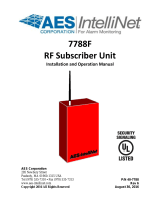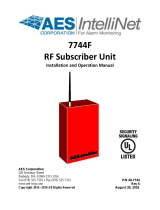
AES•
IntelliNet
Central Alarm Reporting System 08/18/00 - 4000571.p6 Rev B 40-0571
AES•
IntelliTAP
Satellite / Remote Dialer Data Receiver
Page 4
40-0571
LINE CUT MONITOR PROGRAMMING Refer to Figures 1 + 2
The TAP can detect and report a telephone line cut. The TAP determines that the line is cut when the voltage across termi-
nals 1 and 2 drops below approximately 2.5 volts for a programmable period of time. The line cut function is enabled and
its parameters are set using jumpers 6 and 7 (see figures 1+2).
Line cut monitor:
- with 1 minute delay = Jumper on 7
- with 2 minute delay = Jumper on 6
- with 3 minute delay = Jumpers on 6 AND 7
No Phone Line Used, and No Line Cut Monitor = No Jumper
Push Reset Switch (S1) on TAP after setting jumpers.
The line cut function can also be used to supervise the line between the alarm panel and the subscriber unit. See
page 8 in this manual for details.
PROGRAM PHONE NUMBER INTO THE TAP AND ALARM PANEL - Refer to Figures 1 + 2
Select Phone Number and Type: You must select which phone number the TAP is to respond to. Select either the
short (5-5-5) or long (any 15 digit number ending in 2-3-7).
The short number is usually used when the TAP is not connected to an active telephone line.
The long 15 digit number ending in 2-3-7 is preferred when the TAP is connected to an active telephone line. This
allows you to dial a non-obtrusive number and prevent intercept tone, which may occur during TAP and panel commu-
nications when using the short number.
"Short" 3-digit telephone number - Remove jumper on position 5. Program the alarm panel dialer phone number
with the digits 5-5-5. During a reported event, the phone line is quiet after the 5-5-5 is dialed as it waits for more
digits. During this period, the TAP provides an answer tone, signalling to the alarm panel to transmit its data, and then
kisses it off. The control panel then hangs up the line. Test the setup - see next page.
"Long" 15-digit telephone number - Install jumper on position 5. Program the alarm panel with a 15 digit phone
number ending with 2-3-7 (A-E-S). Any numbers can be used, but the last 3 numbers must be 2-3-7. Suggestion:
Program the first digits with the phone number of the line in use. Add additional digits to fill up to digit #12. Avoid
using dual digits such as 11 or 12. During a reported event, this results in "dead air" or a busy signal on the phone line,
but data can usually be conveyed from alarm panel to the TAP if the alarm panel is capable. The control panel then
hangs up the line. Test to make sure this works: If you get a telephone company interrupt tone - a loud series of
tones followed by a voice announcement ("Your call did not go through...") before alarm data has been commu-
nicated, this method will not work. Test the setup - see next page.
NOTE - If Alarm Panel CANNOT Blind Dial, AND you are using a phone line AND you are programming the TAP
for Line Cut: If the telephone line is cut, the line cut will be reported by the TAP, but because the alarm panel cannot
blind dial, no alarm data will be transmitted.
Program the Alarm Panel to Dial the TAP
Follow the alarm panel manufacturer's procedure and enter the appropriate telephone number into the dialer:
Use "5-5-5" if you've selected the "short" number for the TAP.
Use a 15 digit number ending in "...2-3-7" if you selected the "long" number for the TAP.




















